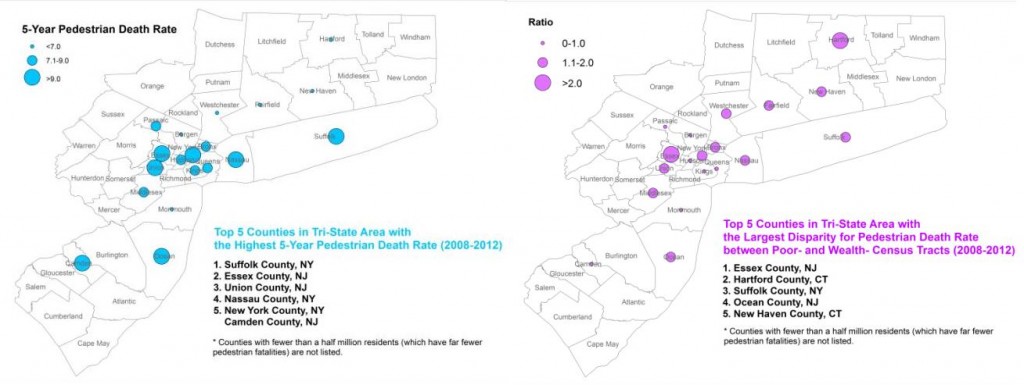A recent study by Governing, Pedestrian Deaths in Poorer Neighborhoods, compiled locational data on all fatal pedestrian accidents within United States metro areas between 2008 and 2012. The study found that in counties across the tri-state region with more than half a million residents—approximately 8.5 pedestrians per 100,000 residents died during the study period. Suffolk County, NY had the highest five-year fatality rate: 12.1 pedestrian deaths per 100,000 residents.
The analysis also looked at pedestrian death rates for income-based census tracts within each county and revealed a significant disparity for fatalities rates between low-income (poverty rate greater than 25 percent) and high-income (poverty rate less than 15 percent) communities. For example, Essex County, NJ had the largest fatality disparity by a ratio of 2.8, which means that within the county, people living in poorer neighborhoods were almost three times more likely to be hit while walking than people in wealthy neighborhoods. The map on the left shows the top five counties with the highest five-year pedestrian death rate, while the map on the right presents the top five counties in the region with the largest disparity in the pedestrian death rate with regard to income.
This pattern is not limited to the tri-state region—the study found that poorer neighborhoods recorded disproportionately higher rates of pedestrian deaths across the United States. According to the report, the pedestrian fatality rates within low-income metro area census tracts were approximately twice that of higher-income metro area census tracts. Neighborhoods with more than 25 percent of residents living below the poverty line had a rate of 12.1 pedestrian deaths per 100,000 people from 2008 through 2012, over two times higher than neighborhoods with a poverty rate below the national average of 15 percent and almost double the national average.
Even though the report didn’t expand upon why this trend is occurring, others have tried. While cities across America have made efforts to improve walkability as a way to spur economic development, typically those efforts focus on a city’s downtown or business district, without considering that low-income residents are often priced out of downtown areas, residing in neighborhoods and suburbs badly in need of pedestrian improvements. Field research conducted by Robert Wood Johnson Foundation found that “In high-income areas, 89 percent of streets had sidewalks, while only 49 percent did in low-income area,” and that marked crosswalks and other traffic calming devices were also significantly less common in low-income communities.
In order to ensure that pedestrian safety gains and economic development are extended to all regardless of income level, policy makers will need to do more to balance transportation investments to communities with high need, and make certain that low-income residents, who are more likely to rely upon walking, biking and public transportation than wealthier residents, have the safe mobility options they deserve.


I find it hard to believe that low-income areas are (basically) more car-oriented than wealthier areas. I would think that most of it would have to do with the fact that low-income people in areas like Essex County are more exposed to the dangers of an auto-centric environment than wealthier residents (even if the lower-income area might be less car-oriented overall).
[…] (This is a post for Mobilizing the Region. Check the original) […]